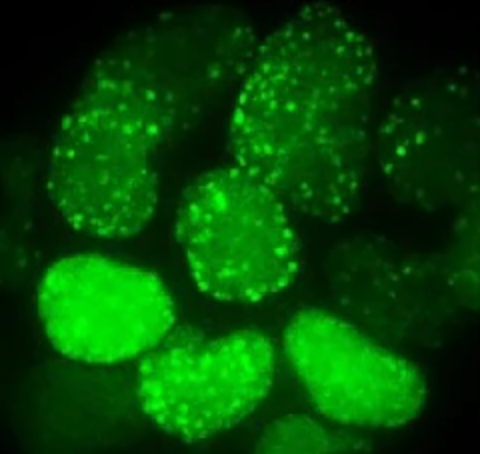Two promising new drugs could be the cure for chronic lower back pain
McGill study identifies drugs targeting zombie cells, providing a potential new cure for chronic low back pain.

McGill scientists discover two drugs targeting zombie cells to treat chronic low back pain at its source. (CREDIT: CC BY-SA 4.0)
Millions of people around the world suffer from chronic low back pain, often finding relief only through temporary solutions like painkillers or invasive surgeries. However, groundbreaking research from McGill University offers new hope. Scientists have identified two promising drugs that tackle the underlying cause—senescent cells, also called "zombie cells."
What Are Senescent Cells?
Senescent cells accumulate naturally with age or due to stress-induced damage, such as DNA injury, oxidative stress, or mitochondrial dysfunction. These cells refuse to die and instead release harmful substances known collectively as the senescence-associated secretory phenotype (SASP).
SASP factors include inflammatory proteins, enzymes, and reactive molecules, which damage healthy tissue and accelerate degenerative diseases, including heart disease, cancer, osteoarthritis, and notably, low back pain.
"Our findings are exciting because it suggests we might be able to treat back pain in a completely new way," explained Lisbet Haglund, senior author of the study and professor at McGill’s Department of Surgery. "By removing the cells driving the problem, not just masking the pain."
Targeting the Root of Pain
To test their approach, the researchers conducted experiments using mice genetically engineered to develop symptoms similar to human spinal degeneration. These mice lack a gene called SPARC, causing early spinal deterioration, inflammation, and chronic pain.
Researchers administered two drugs to these mice: o-vanillin, a natural compound extracted from turmeric, and RG-7112, an FDA-approved drug previously used in cancer treatments. Both drugs individually reduced pain, inflammation, and degeneration in spinal discs, but their combined use showed even more powerful results.
Related Stories
"We were surprised that an oral treatment could reach the spinal discs, which are hard to access and present a major hurdle in treating back pain," Haglund remarked. This discovery highlights an exciting new possibility for effectively managing low back pain at its source, rather than simply addressing symptoms.
How Do These Drugs Work?
The drugs belong to a category known as senolytics, which specifically target and eliminate senescent cells. RG-7112 works by inhibiting proteins involved in cell survival, making it easier for the body to clear away these harmful cells. On the other hand, o-vanillin, initially included almost by accident due to its known anti-inflammatory properties, surprisingly proved capable of removing senescent cells as well.
The researchers also observed improved quality in vertebral bones and significantly reduced expression of pain markers within the spinal cord. This comprehensive improvement underscores the drugs’ potential as transformative therapies for chronic pain.
Why This Research Matters
Low back pain remains the leading cause of disability worldwide, resulting in substantial personal suffering and economic burden, exceeding $100 billion annually in the United States alone. Treatments addressing root causes rather than symptoms could dramatically shift how chronic pain conditions are managed.
This research is particularly promising because senescent cells not only worsen degeneration by releasing harmful substances but also trigger senescence in neighboring healthy cells, creating a damaging cascade. Eliminating these cells early could interrupt this destructive cycle.
Previous studies demonstrated that genetic deletion of specific markers related to senescence, like the protein p16Ink4a, reduced cell accumulation and spinal degeneration. This evidence reinforces the strategy of using senolytics like RG-7112 and o-vanillin to prevent or even reverse damage.
Future Prospects
Although these findings are promising, further studies are necessary to confirm these drugs’ effectiveness and safety in humans. Haglund and her team aim to modify o-vanillin chemically, making it more stable and effective over longer periods in the body. The potential applications extend beyond back pain, possibly benefiting patients suffering from arthritis, osteoporosis, and other age-related diseases driven by senescence.
"The big question now is whether these drugs can have the same effect in humans," Haglund said. If successful, this research could pave the way for a new class of treatments that improve quality of life by directly targeting cellular aging and degeneration.
Comprehensive Study Findings
The study, published in Science Advances and authored by Matthew Mannarino, Hosni Cherif, Lisbet Haglund, and colleagues, provides detailed scientific evidence supporting the use of senolytic drugs for treating chronic back pain.
In the preclinical trial, mice showed reduced pain behaviors, improved spinal health, and diminished inflammatory markers after eight weeks of treatment. This suggests a promising new path forward for millions dealing with debilitating chronic pain conditions.
This advancement reflects a shift toward targeted, biology-based treatments that promise more effective and lasting relief than current symptomatic approaches. With continued research, therapies using RG-7112 and o-vanillin could transform the lives of people suffering from chronic low back pain and other painful degenerative conditions.
Note: The article above provided above by The Brighter Side of News.
Like these kind of feel good stories? Get The Brighter Side of News' newsletter.



